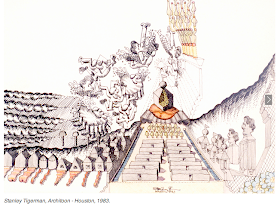You have only through Saturday, May 19th, to view Ceci nʻest pas une rêverie: The Architecture of Stanley Tigerman at the Graham Foundation at Madlener House, 4 West Burton Place.
click images for larger view
Two images that stuck with me after reading Designing Bridges to Burn: Architectural Memoirs by Stanley Tigerman . . . His portrait of his grandfather, a Hungarian tailor, who, after emigrating to America "never worked another day in his life". Instead, he would reinvent himself as a Talmudic scholar, spending his days smoking cheap cigars and studying the Torah. He would take young Stanley under his wing. "At once handsomely well-turned-out and easily enchanting" as would take his grandson along as he went to play cards with his cronies.
It was his grandfather that told Stanley the story of the origins of the family name, of how " . . . a Jewish serf in Hungary who lacked a proper surname" acquitted himself so well in battle behind enemy lines that his superiors bestowed on him a last name appropriate for his bravery, "'tiger" for courage and 'man' for his intelligence" - Tihany, then Tiegermann and finally, at Ellis Island, Tigerman.
And then, the image of Tigerman and his young friends sprawled on the floor drawing, one cartoon after another, increasingly bellicose as World War II approached. After his grandfather's death afflicted him with a Mosaic stutter, Tigerman would say little, but draw a lot.
Tigerman loves dialectics, and he draws the distinction between those who build their lives on intrepretation - Mies van der Rohe, whose architecture can be seen as a re-interpretation of classical architecture in the context of the modern world and its technology - and faith, which would include those who Tigerman refers to as the "sycophants" of Mies, fetishizing the modernist idiom Mies had created while remaining obstinately clueless about the broader streams of knowledge and values that informed it.
These formative influences are all on display at Ceci nʻest pas une rêverie: The Architecture of Stanley Tigerman, which closes at the Graham on Saturday, May 19th. Today, Thursday, May 17th, the Graham is open until 8:00 p.m., with wine and 10% off all bookshop sales.
Ceci n'est pas spreads out over three floors of the Graham with over a hundred drawings, models, and designed objects by Tigerman, The free-form drawings, including the the "architoons" that couple a breezy R. Crumb whimsy to David Macaulay detail, can't help but remind you that kid making cartoons on the floor.
The constant reworking of the past, from the iconic montage of Crown Hall sinking into Lake Michigan, to the neo-classical designs, to the theme of cleaved volumes, and the recurring consideration of Solomon's Temple, culminating in the design of the Illinois Holocaust Museum, measured in cubits, with representations of the temple columns, Jachin and Boaz, uniting two split volumes, one dark, one light . . . all speak to the rich career of a man who "never developed a signature" like a Mies or Frank Gehry style, but has spent a lifetime restlessly interpreting the role and ethics of architecture, who through his work, polemics and activism has made his very life a work of art, its ambitions and imperfections making for an indelibly human portrait.
Rem Koolhaas's latest blockbuster book is again shining the spotlight on the Japanese Metabolists; Tigerman's was already there in his early proposals such as the Instant City, offering up a synchronicity at the time of the movement's fullest flowering. Throughout his life, Tigerman has been a kind of architectural Zelig, present and contributing to the great focal points of his time, from his relationship to Mies, to working with Fazlur Khan in Bangladesh, helping define Post-Modernism, mentoring countless major architects, and, in the end, striving to go beyond the usual "building houses for rich people" to create the new home for the Pacifc Garden Mission.
It's a great show. If you haven't seen it, try to stop by the Graham today and tonight, Friday or Saturday.






No comments:
Post a Comment